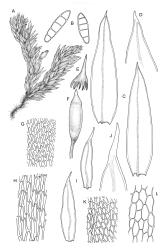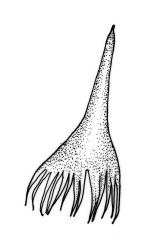- ≡ Daltonia straminea Beckett, Trans. & Proc. New Zealand Inst. 26: 276 (1894)
- ≡ Bellia straminea (Beckett) Broth., Nat. Pflanzenfam. [Engler & Prantl] 1(3), 924 (1907)
Plants bright yellow-green when fresh, yellow-green and moderately lustrous when dry, epiphytic. Stems much-branched, variable in length, commonly c. 20–35 mm, dark brown and wiry, in cross-section with a core of firm-walled cells, no central strand, and 3–4 outer layers of incrassate and pigmented cells, densely beset below with smooth and pale brown rhizoids. Shoots 2.5–3.5 mm wide, curved away from the substrate, weakly complanate. Leaves weakly complanate and secund when moist, scarcely contorted, plicate, and sometimes weakly undulate when dry, oblong-lanceolate, moderately keeled, tapered to a narrowly acute or weakly acuminate and symmetric apex, not or only weakly cuspidate, bordered, narrowly recurved at margins, 2.0–2.3 × 0.40–0.60 mm; upper laminal cells firm-walled, smooth, mostly rounded-rhomboid, mostly 15–24(–30) × 4–6 µm; basal laminal cells linear-rhomboid, firm-walled, occasionally weakly porose; border at mid leaf of c. 6–8 rows of linear and thick-walled cells, narrowing towards apex and not or scarcely fusing with the costa (poorly illustrated here), often obscured by the recurved leaf margin. Costa mostly 30–40 µm wide in lower leaf, subpercurrent, percurrent, or fusing with border and then appearing short-excurrent. Propagulae borne in axillary clusters, fusiform, c. 90–105 µm, transversely septate and mostly 5-celled, on multi-cellular stalks. Paraphyllia lacking.
Dioicous. Perichaetia scattered and usually numerous on ventral surface of the ♀ stems, with inner perichaetial leaves variable in size and shape, to c. 1 mm, ecostate and faintly bordered, some oblong and obtuse or rounded at apices. Perigonia gemmiform, axillary, c. 0.7 mm, strongly pigmented, conspicuous on the dorsal surface of the ♂ stems (which are <10 mm long). Setae c. 2.5–4 mm, flexuose, smooth; capsules inclined, oblong-cylindric, 1.2–1.8 mm, with an ill-defined and tuberculate neck; exothecial cells subquadrate, strongly collenchymatous, arranged in well-defined longitudinal ranks; stomata restricted to neck, superficial; operculum long-rostrate from a conic base, c. 0.6 mm. Peristome inserted at mouth; exostome teeth pale yellow, linear-lanceolate, inrolled when dry, narrowly furrowed (furrow c. 5–8 µm wide), cross-striate on outer surface, with lamellae on inner surface that project laterally as stout marginal trabeculae; endostome extending nearly the length of the teeth, with a basal membrane equal to the uniseriate segments; cilia absent. Calyptra mitrate, laciniate-fringed at base, apparently enclosing the entire capsule. Spores variable in size in a single capsule, often malformed, when well-formed reniform, 21–40 µm, strongly papillose.
Vitt 1977, figs. 1–10; Brotherus 1925, fig. 593 (as Bellia straminea).
Crosbya straminea is sometimes confused, particularly in the field, with Glyphothecium sciuroides. The shoots in the present species are ± complanate and its leaves decidedly secund and c. 0.5 mm wide while the shoots of G. sciuroides are not complanate, its leaves weakly or not secund and c. 1 mm wide. Crosbya straminea leaves have a strong single costa and a strong border, while those of G. sciuroides have weak and double costae and lack a border. The absence of paraphyllia in the present species contrasts with the numerous paraphyllia in Glyphothecium. Both species frequently produce capsules and the smooth capsules of the present species contrast with the striate capsules of G. sciuroides. Crosbya straminea should be readily distinguished from its congener by the features in the key above; it differs from Daltonia splachnoides in many ways, including its overall habit (e.g., complanate shoots and secund leaf orientation), leaf areolation, smooth setae, and the presence of a well-developed endostomal basal membrane.
NI: N Auckland (Waipoua Forest, Tūtāmoe Range), S Auckland, Gisborne (Huiarau Ra, Rākauroa Scenic Reserve, several localities near Lake Waikaremoana), Taranaki (several localities at/near Mt Taranaki), Wellington; SI: Nelson (Ōpārara River, Denniston Plateau, Paparoa Range; Pororari River), Westland, Southland (widespread in Fiordland); St (many localities); Ch. Vitt (1977, fig. 22) provided a distribution map; the general pattern he depicted has altered little with more recent collections, except for a northward range extension to include N Auckland L.D.
Endemic.
On bark of small trees, shrubs, and lianes; usually on smaller branches and twigs. In wet broadleaf-podocarp and southern beech forests, and wet subalpine and coastal scrub. Occurring on a variety of host genera including Aristotelia, Beilschmiedia, Carpodetus, Coprosma, Fuchsia, Griselinia, Hoheria, Laurelia, Melicytus, Pseudopanax, Pseudowintera, Ripogonum, and Weinmannia. Its occurrence as an epiphyte on southern beech is probable, but not documented. From 20 m (Hamilton, S Auckland L.D.) to at least 940 m (Tūroa Road on Mt Ruapehu, Wellington L.D.) on the North I.; from near sea level to at least 600 m (South Branch of Cleddau River, Southland L.D.) on the South I. Frequent close associates include Cladomnion ericoides, Daltonia splachnoides, Dichelodontium nitidum, Ephemeropsis trentepohlioides, Rhaphidorrhynchium amoenum, Weymouthia cochlearifolia, W. mollis, and Metzgeria spp.
Perigonia are rarely observed and I have seen them only in a single Westland L.D. collection (A.J. Fife 10588, CHR 592173); the male stems seen are <10 mm long (considerably smaller than most female stems). The apparent rarity of males and the frequent presence of numerous sporophytes in this species is perplexing.
Sainsbury (1955) applied the name Bellia nervosa (Hook.f. & Wilson) Broth. to material of Crosbya straminea.












